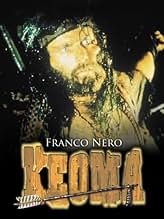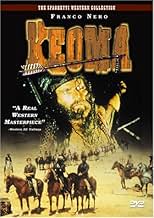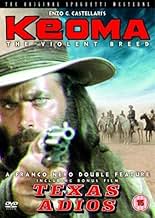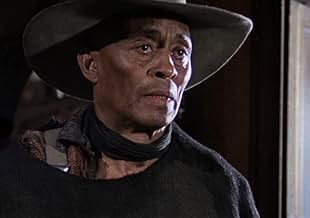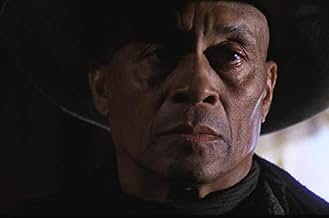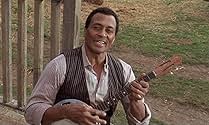VALUTAZIONE IMDb
7,0/10
6585
LA TUA VALUTAZIONE
Un pistolero mezzosangue ex unionista cerca di proteggere la sua città natale, colpita dalla peste, dalle prevaricazioni dei suoi fratellastri razzisti e di un tiranno della Confederazione.Un pistolero mezzosangue ex unionista cerca di proteggere la sua città natale, colpita dalla peste, dalle prevaricazioni dei suoi fratellastri razzisti e di un tiranno della Confederazione.Un pistolero mezzosangue ex unionista cerca di proteggere la sua città natale, colpita dalla peste, dalle prevaricazioni dei suoi fratellastri razzisti e di un tiranno della Confederazione.
- Regia
- Sceneggiatura
- Star
Joshua Sinclair
- Sam Shannon
- (as John Loffredo)
Donald O'Brien
- Caldwell
- (as Donald O'Brian)
Leonardo Scavino
- Doctor
- (as Leon Lenoir)
Antonio Basile
- Caldwell's Henchman
- (non citato nei titoli originali)
Giovanni Bonadonna
- Caldwell's Henchman
- (non citato nei titoli originali)
Armando Bottin
- Caldwell's Henchman
- (non citato nei titoli originali)
Aldo Canti
- Wagon Fugitive
- (non citato nei titoli originali)
- …
Felice Ceciarelli
- Caldwell's Henchman
- (non citato nei titoli originali)
Recensioni in evidenza
This film has so much that works so well, it's a shame one thing keeps it from working entirely l: the music. The single most annoying song I've ever heard in a film. Secondly the newest "restored" version inexplicably has two totally different English voices dubbed for Nero. His first few lines are delivered in a deep clear "radio announcer" pure English baritone, the rest of the film is in a poorly faked accent. What exactly would be the reason for this? Other than those two distractions, a great late era entry to the genre.
After the American Civil War, the half-breed Keoma (Franco Nero) returns to his homeland and rescues a beautiful pregnant woman accused of having plague, Lisa (Olga Karlatos), from a gang leaded by the landlord Caldwell (Donald O'Brian). Later he meets his former slave servant and friend George (Woody Strode), now a drunk free man, and his father, William Shannon (William Berger), and he is informed that the town is under siege of Caldwell's men, without supplies of medicine or food and justice, with the dweller dying of plague and starvation and sick people is being isolated in an old mine. Further, his three dangerous half-brothers have joined Caldwell's force. Keoma decides to help Lisa and the dwellers to retrieve their freedom and dignity, and he finds how despicable the inhabitants are.
The unknown western "Keoma" was a great surprise for me. Although predictable, the story is great, disclosing the relationship of Keoma with his brothers and father through his recollections from his childhood, and does not have a happy commercial end. Franco Nero is amazing in the role of a lonely half-Indian with a great sense of justice and freedom, love and loyalty to his father and regret and resentment to his half-brothers. The direction and cinematography are excellent, with a fantastic choreography of the fights, set decoration and costumes: in the dusty, windy and dirty city, the men's clothes (and themselves) are very dirty, and not like in most of Hollywood movies, where the cowboys wear very clean clothes. There is a particular scene that I believe is unique in the cinema, when Keoma promises four bullets for four hit men, and while bending his four fingers, we see each of his targets. The annoying soundtrack, although having the good intention of creating a narrative of the feelings of the characters, is the only negative aspect in this movie. My vote is seven.
Title (Brazil): "Keoma"
The unknown western "Keoma" was a great surprise for me. Although predictable, the story is great, disclosing the relationship of Keoma with his brothers and father through his recollections from his childhood, and does not have a happy commercial end. Franco Nero is amazing in the role of a lonely half-Indian with a great sense of justice and freedom, love and loyalty to his father and regret and resentment to his half-brothers. The direction and cinematography are excellent, with a fantastic choreography of the fights, set decoration and costumes: in the dusty, windy and dirty city, the men's clothes (and themselves) are very dirty, and not like in most of Hollywood movies, where the cowboys wear very clean clothes. There is a particular scene that I believe is unique in the cinema, when Keoma promises four bullets for four hit men, and while bending his four fingers, we see each of his targets. The annoying soundtrack, although having the good intention of creating a narrative of the feelings of the characters, is the only negative aspect in this movie. My vote is seven.
Title (Brazil): "Keoma"
A half-breed Indian Keoma returns back to his hometown after fighting in the Civil War, and finds his town is being run by an ex-Confederate soldier Caldwell and his outlaws. He holds power over the town by letting the plague infect the inhabitants, and since he won't let any sort of treatment be transported in. He sets up a community for those infected, and this where Keoma rescues a pregnant woman on her way there and returns her back to town. His three half-brothers have joined Caldwell, and I don't think that highly of their brother's return. But loyalty to their father, they won't kill him. His father William Shannon and former family servant/only friend George eventually join Keoma to break the strangle hold Caldwell possess.
Whoa! How good? Real good. Director Enzo G. Castellari's grand looking and interesting spaghetti western comes across as a powerful and beautifully constructed Greek tragedy with a cynical and almost psychological edge bound to it. There's a bit everything chucked into this passionate and intelligent exercise. Breathing high on mood and atmosphere, photographer Aiace Parolin exquisitely frames the mercilessly brooding locations and Castellari's stylishly first-rate direction keeps the film sombre with a brutally unsparing and dirt-laced tone in its dramatic images and context. Good use of abstract lighting and composition, he knows how to keep the viewer at bay with slam-bang set pieces towards the end and a downbeat undercurrent. Inventive framing and exposition also shows the quality of his direction. The glorious slow-motion shootouts and editing technique (ala Sam Peckinpah) are dazzling and how about the constant jumping or leaping in the air. Was there a hidden trampoline on set?! Everything about it held a nice rhythm to it and you just get swept along. Even the flashback sequences are positioned in the story accordingly and in a fulfilling style. The lyrical story is full of symbolic and thematic issues (freedom being the main focal point) that do pack a punch, but also showing a vulnerable side. This gave it a real singular vibe to set it apart from the crowd. Hell, I didn't mind the uncanny and soaring ballad soundtrack too. The way it actually interlocked with the film's sequences, I thought it gave the film some soul and a backbone (well other than always charismatically reliable Nero). A rugged Franco Nero was outstanding. Both mentally and psychically in his scrappy determination and seldom figure Keoma. The impressively committed Woody Strode was excellent. William Berger brought class, and Olga Karlatos decently balanced out an innocent side that really was moving. Donald O'Brien nails it down in a starch turn as the villainous Caldwell.
Whoa! How good? Real good. Director Enzo G. Castellari's grand looking and interesting spaghetti western comes across as a powerful and beautifully constructed Greek tragedy with a cynical and almost psychological edge bound to it. There's a bit everything chucked into this passionate and intelligent exercise. Breathing high on mood and atmosphere, photographer Aiace Parolin exquisitely frames the mercilessly brooding locations and Castellari's stylishly first-rate direction keeps the film sombre with a brutally unsparing and dirt-laced tone in its dramatic images and context. Good use of abstract lighting and composition, he knows how to keep the viewer at bay with slam-bang set pieces towards the end and a downbeat undercurrent. Inventive framing and exposition also shows the quality of his direction. The glorious slow-motion shootouts and editing technique (ala Sam Peckinpah) are dazzling and how about the constant jumping or leaping in the air. Was there a hidden trampoline on set?! Everything about it held a nice rhythm to it and you just get swept along. Even the flashback sequences are positioned in the story accordingly and in a fulfilling style. The lyrical story is full of symbolic and thematic issues (freedom being the main focal point) that do pack a punch, but also showing a vulnerable side. This gave it a real singular vibe to set it apart from the crowd. Hell, I didn't mind the uncanny and soaring ballad soundtrack too. The way it actually interlocked with the film's sequences, I thought it gave the film some soul and a backbone (well other than always charismatically reliable Nero). A rugged Franco Nero was outstanding. Both mentally and psychically in his scrappy determination and seldom figure Keoma. The impressively committed Woody Strode was excellent. William Berger brought class, and Olga Karlatos decently balanced out an innocent side that really was moving. Donald O'Brien nails it down in a starch turn as the villainous Caldwell.
Review of English-language Blue Underground version:
My, my these Spaghettis. In Keoma (Franco Nero), we have a man who has descended into hell, he has become an annihilator. The landscape is infernal, from the Breughelesque sets to the leering henchman to the blasted mountains. For his enemies, he has two barrels of a shotgun, and no pity. The hell is as much in his mind as it is in the town he rides into. He is a man with no place, ideology or purpose. Unlike Eastwood's characters in the dollars trilogy who are without history or neuroses, with Nero as Keoma we have a profound psychological portrait of a man in spiritual agony, on the road to obliteration and self-immolation.
The scenario is also hellish, we have a town and a region that has been taken over by a warlord. He and his henchman block access from and to the outside world. The townsfolk are all infected with a plague, and rather than given access to medical aid, they are put in a concentration camp and forced to mine for silver, or simply murdered. The town is left to the henchmen and their trollops. This for me is very unlike a western in the traditional American sense. In the American western, there are always the upright people of the town to appeal to, there is a sheriff, or as a last resort the cavalry. People may be run off their land or be claim-jumped, but they are never forced into slave labour.
What we have in Keoma, and in similar movies such as Django and Django Strikes Again, is a fundamentally African western, which is probably why Spaghetti goes down so well on that continent. The town in Keoma is more reminiscent of somewhere in Sierra Leone than the Sierra Nevada. There is total brutal oppression of the populace. There is a reckless attitude towards the value of life. Keoma is likewise a more fitting hero for such a landscape, he is almost a Christ-like figure in the sense that he is betrayed or deserted by everyone in this movie, his family, the oppressed, and the liberated. When Keoma is crucified on a wagonwheel the artisans, politicos, henchmen and whores celebrate a change of leadership in the saloon that was entirely down to him. He is constantly grimy, his hair is totally overgrown, he is hirsute, sweaty, and wears no overshirt. Seeing him shove his pistol down the back of his trousers against his bare back will make the ladies a little queasy.
This movie has a very dreamlike atmosphere. The reason for this is that there is no real cohesive plot. Apparently Castellari threw the script in the bin immediately prior to shooting and adopted a completely improvisational approach. The only consistency to the movie is that of image and emotion. Throughout the movie is laced with the anguish of haunted souls, and punctuated by the slow-mo killings after the fashion of Peckinpah. The improvisation can unfortunately be quite clear. Some of the actors were writing their own lines the night before shooting. The dialogue is not always brilliant to say the least, and it is not helped by Nero's far from accent-less English. However this is about the only film where improvisation could work, simply because it is entirely beneficial to the oneiric, logic-less atmosphere.
The De Angelis brothers' soundtrack will be interesting to some because of the untrained voices. Nero sings quite a lot of it himself, and you will have to suspend disbelief and accept it, because although the man clearly has no singing talent, there is an authenticity to his singing that is refreshing.
I'm not sure what Woody Strode was doing in this picture, but flashbacks of him shooting his bow add to the trippiness. Keoma the movie is not quite as far-out as something by Jodorowsky, but it's on the way.
My, my these Spaghettis. In Keoma (Franco Nero), we have a man who has descended into hell, he has become an annihilator. The landscape is infernal, from the Breughelesque sets to the leering henchman to the blasted mountains. For his enemies, he has two barrels of a shotgun, and no pity. The hell is as much in his mind as it is in the town he rides into. He is a man with no place, ideology or purpose. Unlike Eastwood's characters in the dollars trilogy who are without history or neuroses, with Nero as Keoma we have a profound psychological portrait of a man in spiritual agony, on the road to obliteration and self-immolation.
The scenario is also hellish, we have a town and a region that has been taken over by a warlord. He and his henchman block access from and to the outside world. The townsfolk are all infected with a plague, and rather than given access to medical aid, they are put in a concentration camp and forced to mine for silver, or simply murdered. The town is left to the henchmen and their trollops. This for me is very unlike a western in the traditional American sense. In the American western, there are always the upright people of the town to appeal to, there is a sheriff, or as a last resort the cavalry. People may be run off their land or be claim-jumped, but they are never forced into slave labour.
What we have in Keoma, and in similar movies such as Django and Django Strikes Again, is a fundamentally African western, which is probably why Spaghetti goes down so well on that continent. The town in Keoma is more reminiscent of somewhere in Sierra Leone than the Sierra Nevada. There is total brutal oppression of the populace. There is a reckless attitude towards the value of life. Keoma is likewise a more fitting hero for such a landscape, he is almost a Christ-like figure in the sense that he is betrayed or deserted by everyone in this movie, his family, the oppressed, and the liberated. When Keoma is crucified on a wagonwheel the artisans, politicos, henchmen and whores celebrate a change of leadership in the saloon that was entirely down to him. He is constantly grimy, his hair is totally overgrown, he is hirsute, sweaty, and wears no overshirt. Seeing him shove his pistol down the back of his trousers against his bare back will make the ladies a little queasy.
This movie has a very dreamlike atmosphere. The reason for this is that there is no real cohesive plot. Apparently Castellari threw the script in the bin immediately prior to shooting and adopted a completely improvisational approach. The only consistency to the movie is that of image and emotion. Throughout the movie is laced with the anguish of haunted souls, and punctuated by the slow-mo killings after the fashion of Peckinpah. The improvisation can unfortunately be quite clear. Some of the actors were writing their own lines the night before shooting. The dialogue is not always brilliant to say the least, and it is not helped by Nero's far from accent-less English. However this is about the only film where improvisation could work, simply because it is entirely beneficial to the oneiric, logic-less atmosphere.
The De Angelis brothers' soundtrack will be interesting to some because of the untrained voices. Nero sings quite a lot of it himself, and you will have to suspend disbelief and accept it, because although the man clearly has no singing talent, there is an authenticity to his singing that is refreshing.
I'm not sure what Woody Strode was doing in this picture, but flashbacks of him shooting his bow add to the trippiness. Keoma the movie is not quite as far-out as something by Jodorowsky, but it's on the way.
Castellari's Keoma was part of the late 1970's second wave of spaghetti westerns. It is typically considered one of the better entries in the genre, some even rate it as a classic alongside Leone's masterpieces. However, while it has clearly been attempted to make the film look stylish and sophisticated, and at a casual glance it does look pretty well made, a more in depth look shows that it falls quite a long way off the mark.
Basically, it's clear that what Castellari has is a bunch of director's tricks up his sleeve - slow motion, unconventional camera angles, subtle merges into flashbacks and so on - all of them thieved from the work of other filmmakers. That in itself is no bad thing - after all Tarantino has made a career out of doing the same - but the difference is that Castellari clearly has no idea how and when to use these techniques. He simply throws them in at every opportunity, so that they actually stick out rather than enhance the film. The most obvious example is the Sam Peckinpah style slow motion deaths after someone is shot. In Peckinpah's films it was used skilfully to highlight the brutality of certain killings here and there throughout the movie. In Keoma it is used more or less every time someone is shot - about forty or fifty altogether - totally losing any impact it might have had.
Add to this that Keoma is a completely boring spaghetti western character - basically just a hippy with a colt - and not one of Franco Nero's better performances. The dialogue is terrible. The plot is text book spaghetti western back-for-revenge. This movie doesn't really have a lot going for it.
And then there is the music, famous itself among spaghetti western fans for being almost unlistenably bad, which seems to sum up the feeling of the entire film. Quite a nice melody, but either sung in a piercing shriek by the female vocalist or an unnerving growl by the male vocalist.
In short Keoma is a perfect example of style over substance - it's all dazzling flair in an attempt to cover up a pretty poor film. Viewers should stick to the real classic spaghettis like Sergio Leone and Sergio Corbucci's work.
Basically, it's clear that what Castellari has is a bunch of director's tricks up his sleeve - slow motion, unconventional camera angles, subtle merges into flashbacks and so on - all of them thieved from the work of other filmmakers. That in itself is no bad thing - after all Tarantino has made a career out of doing the same - but the difference is that Castellari clearly has no idea how and when to use these techniques. He simply throws them in at every opportunity, so that they actually stick out rather than enhance the film. The most obvious example is the Sam Peckinpah style slow motion deaths after someone is shot. In Peckinpah's films it was used skilfully to highlight the brutality of certain killings here and there throughout the movie. In Keoma it is used more or less every time someone is shot - about forty or fifty altogether - totally losing any impact it might have had.
Add to this that Keoma is a completely boring spaghetti western character - basically just a hippy with a colt - and not one of Franco Nero's better performances. The dialogue is terrible. The plot is text book spaghetti western back-for-revenge. This movie doesn't really have a lot going for it.
And then there is the music, famous itself among spaghetti western fans for being almost unlistenably bad, which seems to sum up the feeling of the entire film. Quite a nice melody, but either sung in a piercing shriek by the female vocalist or an unnerving growl by the male vocalist.
In short Keoma is a perfect example of style over substance - it's all dazzling flair in an attempt to cover up a pretty poor film. Viewers should stick to the real classic spaghettis like Sergio Leone and Sergio Corbucci's work.
Lo sapevi?
- QuizThe story line of the film was mostly improvised at the same time as the film was made. The original story treatment was written by Luigi Montefiori (aka George Eastman) and turned into a script by Mino Roli and Nico Ducci, but director Enzo G. Castellari didn't like what had been written by the latter two. Because of problems with the schedule, Castellari and actor Joshua Sinclair wrote the script for the next day every evening after filming of the day. Castellari was also open to suggestions from the cast and crew - Franco Nero has confirmed that he wrote some of his own dialogue.
- BlooperAt 7:08 riders on horseback in pursuit of two men running on foot fire their pistols. Both men on foot react as if hit by the first shot.
- Versioni alternativeGerman version was cut for violence and pacing reasons by 8 minutes to secure a "not under 16" rating. Despite that, it still got put on the index list by the BPjM which means various sales and advertising restrictions. Fortunately in 2003, the movie was removed from the index list and the FSK granted the uncut version a "not under 16" rating.
- ConnessioniFeatured in L'Oeil du cyclone: Westernissimo (1995)
- Colonne sonoreKeoma
(uncredited)
Music by Guido De Angelis & Maurizio De Angelis
Lyrics by Susan Duncan Smith and Cesare De Natale
Performed by Sibyl Mostert and Cesare De Natale
I più visti
Accedi per valutare e creare un elenco di titoli salvati per ottenere consigli personalizzati
- How long is Keoma?Powered by Alexa
Dettagli
Contribuisci a questa pagina
Suggerisci una modifica o aggiungi i contenuti mancanti


